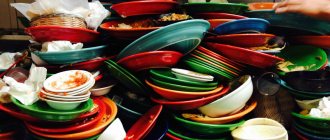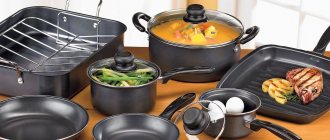It’s not at all easy to move from a long-established place and move your favorite sofa and other furnishings to a new apartment, sometimes located hundreds of kilometers away. You will inevitably think about how to make sure that during transportation nothing gets damaged, broken, lost or broken.
You can, of course, trust professionals from special services, but many people like to do it themselves. And the reason is not only cost savings. If you know how to properly lay and pack things, the chances that losses during the transportation of things will be minimized will increase sharply.
You can learn more about what we need to pack household items from the previous article. Today we will talk about how to pack this or that item specifically. Let's start with fragile items that require special care and attention when preparing for moving.
How to load boxes of dishes into a car
If you are transporting dishes in a passenger car, follow these rules when loading boxes of dishes:
- Do not place them on seats as they may fall over. The best option is to place them on the floor behind the front seats;
- If you have to transport boxes of dishes in the trunk, be sure to make sure that they are securely secured. Almost every car has ways to secure cargo in the trunk, using belts or various fastenings. If this is not possible, secure boxes with dishes in the corner of the trunk using other heavier boxes, but so that they do not put pressure;
- The driver of the vehicle must be aware that he is carrying fragile items in order to adjust his driving style.
How to transport furniture?
Inspect all the furniture in advance and decide what you will transport. It may make sense to get rid of some bulky old things, even because old furniture that has seen wear and tear may simply fall apart when reassembled after moving.
The next step is to determine what of the remaining furniture can be disassembled and what will have to be transported entirely. Walls, beds, tables, large sofas and wardrobes need to be dismantled. This way they will take up less space during transportation and will easily fit through the doorway.
Place all small parts, spare parts, fasteners, fittings, bolts, screws, keys and handles in separate bags, sign what furniture they belong to, and put them in a separate box (do not attach them to a package with disassembled furniture (they may come off and get lost) during transportation) with the inscription “accessories”.
There you can also put the necessary tools for assembling furniture in a new apartment - screwdrivers, pliers, universal wrenches, screws, nails.
Panels, shelves, doors of collapsible furniture need to be folded equal sides one to one, lined with cardboard or other packaging material, wrapped with film, sheets of corrugated cardboard and secured with tape, making handles for carrying. Number and make appropriate notes in your notebook. Fragile parts of furniture, corners, protruding parts additionally need to be glued with tape or special sponge rubber.
Wrap sofas, armchairs, small cabinets and anything that cannot be taken apart (after securing the doors and drawers and removing all protruding parts and handles) with stretch film and secure with tape to protect from dirt, dust and scratches.
It is advisable to number the dismantled shelves and drawers so that they can be hung or inserted in the same order.
For convenience, all boxes and packages with disassembled furniture can be equipped with adhesive tape handles.
Preparing for transportation and packing fragile items
There are always a lot of things in the house that require special preparation and packaging for moving.
Tip: Boxes with fragile and breakable items should be provided with warning signs: “Glass!”, “Caution, fragile!” and mark where the top and bottom of the boxes are.
TV and monitor packaging
Modern plasma and LCD TVs, unlike older models with glass screens, are especially sensitive to shock. To prevent anything from happening, you need to follow some rules when packing them.
The best way to transport a TV, or any household appliance, is in its original packaging, secured in a box with foam or wrapped in bubble wrap and filling all empty spaces with newspapers or soft things.
But few of us keep boxes from purchased household appliances. Therefore, we proceed as follows:
- We wrap the TV in air bubble wrap, while on the screen side we make an additional seal of film in three layers, using tape to secure it. Then we pack it in corrugated cardboard.
- You need to transport the TV in an upright position, with the screen facing a large, flat surface and placing something soft between them, for example a blanket, but without knots or folds.
Transporting an aquarium
The main condition for transporting the inhabitants of the aquarium is to create normal conditions, that is, the usual temperature. To do this, the fish must be placed in a container with a tight lid and water taken from the aquarium.
Experts recommend taking old water with you and filling the aquarium with it in a new place, diluting it with fresh water prepared in advance.
Separately, we are preparing a fish house for moving. Its walls, outside and inside, are first lined with cardboard and secured with tape. Then it is completely wrapped in bubble wrap, which is also fixed.
Packing the paintings
Transportation of paintings, especially valuable and old ones, requires special care so as not to damage the base canvas and the paint layer. Everything is important here: you need to eliminate the effects of temperature fluctuations and dust penetration, ensure the necessary air humidity (too dry or excessively humid air is equally harmful to paints).
It is best to transport the painting in a specialized container, having first freed it from the frame. If there is none, it can be packed in fairly thick paper and wrapped with bubble wrap on top. Do not stick tape directly to the surface of the canvas with paints.
The frame is packaged separately with the corners protected from impacts and in a vertical position. In addition, paintings can be packed in twos, with the front side inward, with cardboard or a thick layer of paper placed between them so as not to scratch the paintwork.
How to pack dishes, vases, crystal and other fragile items?
There are always many objects in the house that are easy to break and break. When transporting fragile items, it is important to prevent their contact with each other, the presence of voids in the box and the mobility of objects in it. To wrap them, you can use crumpled newspapers, wrapping paper, towels, old magazines (sheets can be placed between plates and wine glasses and mugs can be wrapped in them), scarves, socks, and hats.
The inside of the box can be divided into separate sections according to the size of the items, into which they are placed one at a time, pre-wrapped in bubble wrap or paper. The remaining free space in the box and its upper part must be filled with crumpled newspapers, soft things, towels, closed and sealed with tape.
Be sure to write with a bright marker that the box contains fragile items.
Porcelain figurines, delicate glass and crystal glasses can be packed in plastic containers, after wrapping each item separately with cling film, paper, or placing the fragile item in a sock (a very effective method).
As for the plates, it is recommended to transport them by wrapping each one separately in packaging material in an upright position and separating one from the other with a piece of cardboard. In a car in which things are transported, boxes with dishes must be placed so that they do not move while driving. You can't put anything on top of them.
Chandelier packaging
If this is possible, then the chandelier needs to be disassembled, the shades and all breakable items removed from it and packaged separately. If this cannot be done, the chandelier should be wrapped in protective film and placed in a box according to size. All voids are compacted as much as possible to ensure its immobility during transportation.
We transport mirrors and glass
Thick cardboard is fixed to the front side of the mirror and the whole thing is completely wrapped in bubble wrap, which is secured with tape. During transportation, the mirror should not move, and something soft should be placed under the packaging.
Glass of the same size (for example, furniture shelves or doors) can be sandwiched between each other with cardboard, paper, or newspapers. Then cover everything together with cardboard and wrap it in packaging film or thick fabric, tie it tightly or secure it with tape.
Where to get boxes for packing things
Boxes for packing things do not have to be new.
If you think this statement is incorrect, then you can buy them at the post office or from a specialized packaging company. If you're ready to pack items in boxes that have been used but are still clean and in shape, you can take a walk to the nearest supermarket. In large stores, the goods come in corrugated containers, so they have a large number of boxes left over.
Many stores dispose of them in the prescribed manner, but if you ask store employees for unnecessary containers, you are unlikely to receive a refusal.
There are usually a lot of empty boxes in places of open trade - in markets. In this case, it is enough to choose a fine day (the boxes are usually laid out in the open air) and approach the market closer to closing.
Perhaps your place of work also has a lot of unnecessary boxes - in a warehouse, at a supply manager, etc.
How to pack things correctly
So, you have chosen the appropriate container. The moment of immediate preparation for the move has come - time to collect and pack things.
Monitor the weight of the boxes and do not overload them. This is inconvenient when moving them and increases the risk of rupture. Packed boxes should not be heavier than 10-15 kg.
The general principle for packing any things is to place heavier things (for example, books) at the bottom of the box, and you can place something lighter on top.
For packaging light bulky items - clothes, bedding, children's toys - medium-sized boxes are well suited (in our online store these are “universal boxes”).
It is better to put dishes, books, and other heavier things and objects in smaller boxes to prevent overload.
One of our favorite lifehacks. Clothes “on hangers” are so convenient to transport packed in wardrobe boxes - nothing will get wrinkled or dirty.
Shoes are placed in their own boxes or in common containers. In the second case, stack the shoes on top of each other and line each item with paper or bubble wrap.
Fragile items, dishes, vases are especially often at risk during moves.
Protect them additionally - pack them in several layers of bubble wrap, secure it with adhesive tape, and only then carefully place them in boxes. They need to be loaded into the body no less carefully.
Small potted indoor plants are easy to pack: place them in a suitable sized box, filling the spaces between them with wrapping paper, for example. The main thing is to monitor the temperature during transportation!
Immediately try to place packed items in the room compactly. Most likely, there will be a lot of boxes; they should not clutter up the space or interfere with you until the day of the move. Do not stack heavy boxes on top of each other - the bottom one may not be able to withstand the load.
How to transport fragile dishes
First of all, let's look at fragile dishes, namely, all kinds of plates, glasses, dishes, salad bowls and similar items.
The main goal when transporting them is not to break or create spalls.
To transport fragile dishes you will need:
- Thick boxes (or wooden boxes). The first option is more practical, since the final weight of a wooden box with glassware will be much higher;
- Thick cardboard;
- Filler. This could be wrapping paper, old newspapers, foam chips, sawdust, and so on;
- Wrapping film. In this case, it is best to use bubble wrap. But it can't be found everywhere. If you can’t purchase bubble wrap, you can use regular one;
- Rags or other rags;
- Wrapping paper.
Packaging of household appliances
Refrigerators, microwave ovens, washing machines and dishwashers are packaged in approximately the same way and require special care.
Let's look at packaging using the example of a refrigerator. It is advisable to defrost and wash the refrigerator a day before moving. In order not to damage the internal surface when tilting and carrying, you need to remove containers, shelves, and all removable parts from it (or fix it inside) and pack them separately.
Also remove the power cord and securely fix the door. Cover the walls of the refrigerator with thin cardboard and wrap with stretch film in 1-2 layers or bubble wrap in 1 layer. The compressor (power unit of the refrigerator) must be secured with special bolts during transportation (in modern models these bolts cannot be removed).
Important: when choosing a car for moving, focus on the tallest object in your apartment. Most often this is a refrigerator, which is recommended to be transported in a vertical position (transportation on its side or in a horizontal position can lead to its breakage).
Care should also be taken when transporting the washing machine. Before packing it, you must disconnect the hoses and drain the water. It is better to cover the back part with foam rubber and seal it with wide tape. If possible, secure the drum with mounting screws, and during the move it can be protected from loosening by filling it with soft toys, sheets, and towels. The machine should be packed in bubble wrap and then wrapped with 1-2 layers of stretch film.
We pack small household appliances in boxes according to size, pre-wrapped in packaging film or lined with soft cloth. In a microwave oven, you must first fix the glass tray inside. It is recommended that you back up important data before packing your computer for moving. The monitor should be packed in the same way as the TV. When packing household appliances, we focus on the manufacturer’s recommendations. We mark the top and bottom of the box and the front of the product.











